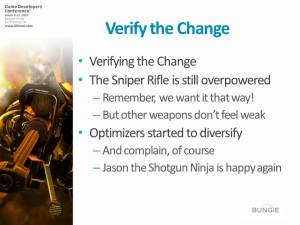And there it is! The big detail!It’s a large change. It’s very easy to convince yourself that you can feel tiny changes, but you will be fooling yourself. The balance never hinges on a 2% difference in a single value!
It was a smaller change than we tried initially. I think originally we changed it to 0.9, which broke the flow and wrecked the weapon, but did fix the problem, so we knew we were on the right track. In general, you want to overshoot and then come back. You have to make sure your change accomplishes your goal, and then dial it back.
There are lots of ways to verify that a change was successful. In this case, the Sniper Rifle didn’t get any less popular; People still use it whenever they can get it. But Optimizers stopped using it exclusively.
The other reason we could tell it was balanced was because we could compare how the behavior we were seeing in playtests matched the desired role we described in our paper design. It’s not quite an objective test, but it should help. And most importantly, I no longer got nervous when I watched people use the Sniper Rifle. You should verify a change with both your brains and your guts.
At this point during my GDC talk, the audience started clapping, cluing me into the fact that I was completely out of time.
So I just went with the flow and ended it there, which was fine. I had walked people through the balancing process, brought up the important principles, and applied them to the sniper rifle change. But I had also intended to mention a couple of things about the last stages of balancing, which I will get into next week!




